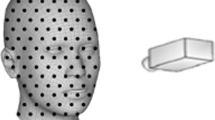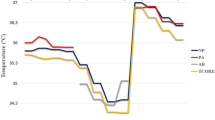Summary
Question of the study
Ventilatory masks are crucial for the quality of ventilation as well as for the acceptance of therapy. While a comfortable fit is important for acceptance, air-tightness of the mask will determine the quality of ventilation. As leakage quantification of BIPAP therapy has already been established, we are now introducing a method to localize such leakage.
Methods
Ventilatory masks that are not airtight will have a high flow air current in between the face mask and the facial skin. This current will result in a drop in temperature of the skin surface already after a few minutes in the leaking area. Thermography (NEC TH 71 thermal imager) can localize these skin areas and thus the corresponding areas of the mask.
Results
Existing leakages were detected in every case. The regional decrease in skin temperature turned out to be 3–5°C. In the case of individual masks, the leaking part of the mask was clearly detected for further revision by the dental technician. Refinement of the mask resulted in satisfactory air-tightness and good quality of ventilation.
Discussion
While instituting BIPAP therapy thermographic leak imaging appears to be an efficacious method that enlarges the methodological inventory for leakage evaluation. Especially for the manufacturer of individual masks, exact leak detection will result in a successful solution for the patient, the physician, and the dental technician. The disadvantages of this method are that it is quite costly and that deficient consideration was given that different body positions might have a variable impact on leakage.
Zusammenfassung
Fragestellung
Die Beatmungsmaske ist von entscheidender Bedeutung für die Qualität der Beatmung und die Akzeptanz der Therapie. Für eine hohe Akzeptanz ist insbesondere ein komfortabler Sitz erforderlich, während die Beatmungsqualität entscheidend von der Dichtigkeit der Maske mitbestimmt wird. Nach der bereits etablierten Quantifizierung der Leckage unter BiPAP-Therapie wird nun eine Methode zur Lokalisierung der Leckage vorgestellt.
Methodik
An undichten Stellen einer Beatmungsmaske tritt mit relativ hoher Geschwindigkeit Luft zwischen dem Rand der Maske und der Haut aus dem Beatmungssystem aus. Dieser Luftstrom führt schon nach wenigen Minuten zur Abkühlung der Hautoberfläche im Bereich des Luftaustritts. Mittels Thermographie (NEC TH 71 Wärmebildkamera) können die abgekühlten Hautstellen und damit die zugehörigen Bereiche des Maskenrandes lokalisiert werden.
Ergebnisse
Vorhandene Leckagen konnten in jedem Fall per Wärmebild lokalisiert werden. Die lokale Abkühlung der Hautoberfläche betrug 3–5°C. Im Falle individueller Masken konnte für den Zahntechniker eindeutig der Bereich der Maske eingegrenzt werden, der noch verstärkt werden musste. Die Ausbesserung führte in jedem Fall zu einer zufriedenstellenden Dichtigkeit der Maske mit entsprechend verbesserter Beatmungsqualität.
Diskussion
Im Rahmen der Einstellung auf BiPAP-Therapie wird mit der thermographischen Leckagedarstellung das Methodeninventar der Leckageerfassung um ein effizientes Verfahren erweitert. Insbesondere bei der Anfertigung individueller Masken führt die genaue Leckagelokalisierung zu einem schnellen Erfolg für Patient, Arzt und Zahntechniker. Nachteilig sind die relativ hohen Kosten des Verfahrens, sowie die unvollständige Berücksichtigung des Einflusses verschiedener Schlafpositionen auf die Leckage.
Similar content being viewed by others
References
Kerl J, Klauke M, Suchi S, Schönhofer B: Methode zur Quantifizierung der Maskenleckage bei Beatmung mit Druckvorgabe (BiPAP-Therapie). 9. Deutscher Kongress für Schlafforschung und Schlafmedizin, Hamburg, 13.–15.09.2001. Somnologie Suppl 2(5): 28, 2001.
Kerl J, Köhler D, Schönhofer B: Qualitativer Nachweis von Mundatmung und Mundleckagen unter CPAP-Therapie bei OSA. 8. Deutscher Kongress für Schlafforschung und Schlafmedizin, Norderney, 15.–18.10.2000. Somnologie Suppl 1(4): 38, 2000.
Author information
Authors and Affiliations
Corresponding author
Rights and permissions
About this article
Cite this article
Kerl, J., Wenzel, M. & Köhler, D. Thermal imaging of mask leakage during pressure-controlled ventilation (BIPAP therapy). Somnologie 8, 83–86 (2004). https://doi.org/10.1111/j.1439-054X.2004.00022.x
Received:
Accepted:
Issue Date:
DOI: https://doi.org/10.1111/j.1439-054X.2004.00022.x




